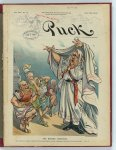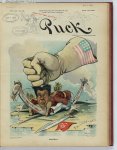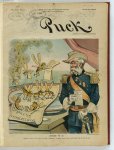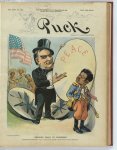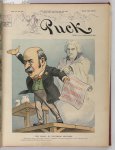Learning from the Source: Perspectives on U.S. Expansion

At the turn of the 20th century Admiral George Dewey, Pacific naval commander, became a veritable American hero for his role in the Spanish-American war. While United States foreign policy was focused on global expansion, not everyone believed it was a good idea. The Philippines, certainly, were not keen on U.S. imperialism and continued to fight for control of the country until 1902 (Spain “awarded” the Philippines to the United States for $20 million under the 1898 Treaty of Paris). Use the political cartoon primary source set below (as well as the cartoon above) to consider how the political magazine Puck portrayed different U.S. perspectives of expansionism from 1899-1902 in relation to the Philippines. Use the accompanying resources to help inform and guide student analyses. You may choose to have students analyze the cartoons twice, first without reviewing the bibliographic record or any other texts and again after the review of these records and materials. Look to the Common Core State Standards alignments below to inform additional activity tasks.
Enduring Understanding National interest shapes foreign policy
Focus Question How did U.S. national interests impact Philippine liberty and democracy around the turn of the 20th century?
Primary Source Set
Political cartoon set (list)
Historical Resources
- Chronology for the Philippine Islands and Guam in the Spanish-American War (Library of Congress)
- Emilio Aguinaldo y Famy (Library of Congress)
- The Philippine-American War, 1899–1902 (U.S. Department of State, Office of the Historian)
- The Philippine-American War (Office of Multicultural Student Services University of Hawai’i)
- A New History of the Philippine-American War” (New York Times book review of Honor in the Dust, by Gregg Jones)
- Puck Magazine (description from the Theodore Roosevelt Center, Dickinson State University)
- Manila, or Monroe doctrine? (c 1898) Anti-Carnegie scraps and comments (1899)
- The War in the Philippines (1899)
- An epitome of historical events and of official and other correspondence connected with the acquisition and other dealings of the United States with the Philippine Islands (1902)
Understanding & Analyzing Political Cartoons
- Persuasive techniques of political cartoons (symbolism, exaggeration, labeling, analogy, irony)
- The [political] Cartoon by Herb Herblock
- Analyzing Primary Sources: Learning from Political Cartoons
Common Core State Standards Alignment
English Language Arts Standards » History/Social Studies » Grades 6-8
- RH.6-8.1. Cite specific textual evidence to support analysis of primary and secondary sources.
- RH.6-8.2. Determine the central ideas or information of a primary or secondary source; provide an accurate summary of the source distinct from prior knowledge or opinions.
- RH.6-8.4. Determine the meaning of words and phrases as they are used in a text, including vocabulary specific to domains related to history/social studies.
- RH.6-8.5. Describe how a text presents information (e.g., sequentially, comparatively, causally).
- RH.6-8.6. Identify aspects of a text that reveal an author’s point of view or purpose (e.g., loaded language, inclusion or avoidance of particular facts).
- RH.6-8.7. Integrate visual information (e.g., in charts, graphs, photographs, videos, or maps) with other information in print and digital texts.
- RH.6-8.8. Distinguish among fact, opinion, and reasoned judgment in a text.
- RH.6-8.9. Analyze the relationship between a primary and secondary source on the same topic.
- RH.6-8.10. By the end of grade 8, read and comprehend history/social studies texts in the grades 6–8 text complexity band independently and proficiently.
English Language Arts Standards » History/Social Studies » Grades 9-10
- RH.9-10.1. Cite specific textual evidence to support analysis of primary and secondary sources, attending to such features as the date and origin of the information.
- RH.9-10.2. Determine the central ideas or information of a primary or secondary source; provide an accurate summary of how key events or ideas develop over the course of the text.
- RH.9-10.3. Analyze in detail a series of events described in a text; determine whether earlier events caused later ones or simply preceded them.
- RH.9-10.4. Determine the meaning of words and phrases as they are used in a text, including vocabulary describing political, social, or economic aspects of history/social science.
- RH.9-10.6. Compare the point of view of two or more authors for how they treat the same or similar topics, including which details they include and emphasize in their respective accounts.
- RH.9-10.8. Assess the extent to which the reasoning and evidence in a text support the author’s claims.
- RH.9-10.9. Compare and contrast treatments of the same topic in several primary and secondary sources.
- RH.9-10.10. By the end of grade 10, read and comprehend history/social studies texts in the grades 9–10 text complexity band independently and proficiently.
English Language Arts Standards » History/Social Studies » Grades 11-12
- RH.11-12.1. Cite specific textual evidence to support analysis of primary and secondary sources, connecting insights gained from specific details to an understanding of the text as a whole.
- RH.11-12.2. Determine the central ideas or information of a primary or secondary source; provide an accurate summary that makes clear the relationships among the key details and ideas.
- RH.11-12.3. Evaluate various explanations for actions or events and determine which explanation best accords with textual evidence, acknowledging where the text leaves matters uncertain.
- RH.11-12.6. Evaluate authors’ differing points of view on the same historical event or issue by assessing the authors’ claims, reasoning, and evidence.
- RH.11-12.7. Integrate and evaluate multiple sources of information presented in diverse formats and media (e.g., visually, quantitatively, as well as in words) in order to address a question or solve a problem.
- RH.11-12.8. Evaluate an author’s premises, claims, and evidence by corroborating or challenging them with other information.
- RH.11-12.9. Integrate information from diverse sources, both primary and secondary, into a coherent understanding of an idea or event, noting discrepancies among sources.
- RH.11-12.10. By the end of grade 12, read and comprehend history/social studies texts in the grades 11–CCR text complexity band independently and proficiently.

